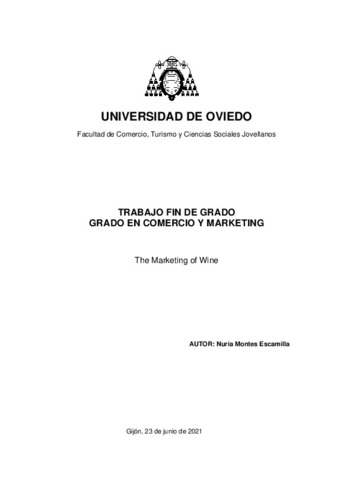The Marketing of Wine
Otros títulos:
El Marketing del vino
Autor(es) y otros:
Director(es):
Centro/Departamento/Otros:
Palabra(s) clave:
Marketing of wine
Marketing case study
Market wine analysis
Fecha de publicación:
Serie:
Grado en Comercio y Marketing
Descripción física:
Resumen:
The market of wine has been growing increasingly over the past decades. It is relevant at national and international level because it is a widely consumed product. By introducing the wine market and its scope, we found that it is a distinct market, which relies mainly on internationalisation and trade between countries for the survival of the many companies it holds. Analysing the characteristics of premium wine to find out what attributes are given by the beverage itself and which values are added by the companies through the brand. The combination of both sets of attributes would make the premium wine appeal the different types of consumers, who demand both domestic and foreign wines. Through the means-ends chain theory we are be able to identify four segments of wine consumers which in general are highly risk adverse. The marketing tools used by the companies should focus on building brand image to reduce risk. Besides, it is found that the brand image and the available information at the store are the most relevant factors for consumers to decide. The methods used would vary depending on the resources on the company and the attributes that are appreciated by its target customers. Through a case study of Bodega Palomares, a Spanish wine company, an implementation of improvements is proposed in order to enhance the relationship with the customer, thus reducing the risk.
The market of wine has been growing increasingly over the past decades. It is relevant at national and international level because it is a widely consumed product. By introducing the wine market and its scope, we found that it is a distinct market, which relies mainly on internationalisation and trade between countries for the survival of the many companies it holds. Analysing the characteristics of premium wine to find out what attributes are given by the beverage itself and which values are added by the companies through the brand. The combination of both sets of attributes would make the premium wine appeal the different types of consumers, who demand both domestic and foreign wines. Through the means-ends chain theory we are be able to identify four segments of wine consumers which in general are highly risk adverse. The marketing tools used by the companies should focus on building brand image to reduce risk. Besides, it is found that the brand image and the available information at the store are the most relevant factors for consumers to decide. The methods used would vary depending on the resources on the company and the attributes that are appreciated by its target customers. Through a case study of Bodega Palomares, a Spanish wine company, an implementation of improvements is proposed in order to enhance the relationship with the customer, thus reducing the risk.
Notas Locales:
Trabajo Fin de Grado Comercio y Marketing
Colecciones
- Trabajos Fin de Grado [2068]
Ficheros en el ítem





